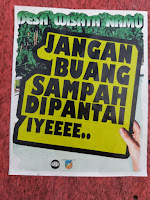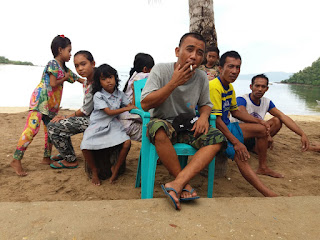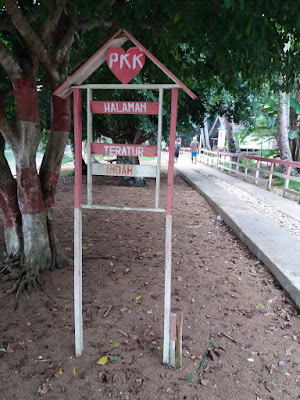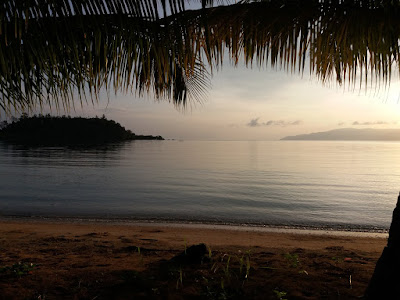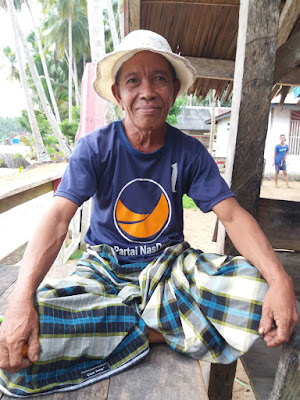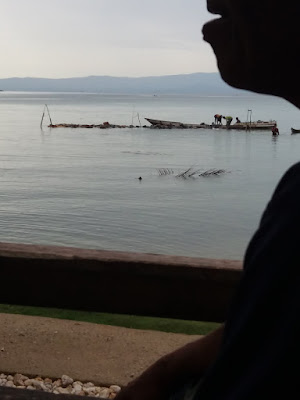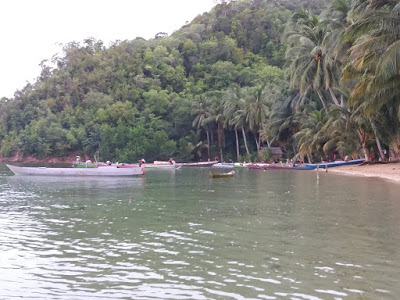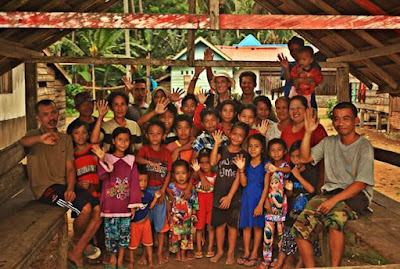"Don't throw rubbish
on the beach." says Desa Wisata Namu.
In November 2016 I returned to Kendari, Southeast Sulawesi. When discussing possible destinations with my Indonesian friends I was very surprised to hear of a village that had not yet been visited by any foreigner! To be the first international visitor anywhere is a real achievement in today's world. Yet Desa [Wisata] Namu, Namu Tourist Village, is already actively preparing to accommodate us.
I travelled with Dheny Lahundape, good friend and professional photographer from Kendari.
A car provides regular service from Kendari to Pelabuhan Amolengo in Kecamatan Kolono Timur [East Kolono District], Kabupaten Konawe Selatan [South Konawe Regency]. The journey takes about 2 hours.
💜Map : Pelabuhan Amolengo and Desa Namu
On days when the ferry transports hundreds of people and their goods to and from Desa Labuan Bajo on Pulau Buton Utara, this would be a crowded, bustling place.
Until 2016, the only ferries were motorised perahu, which must transport goods, people, even motorbikes. Now the ferry is a far more commodious transporter, able to take hundreds of people and their goods safely from an impressive new jetty. Our journey to Desa Namu in Kec. Laonti continued in one of the motorised perahu, a small local open boat, from the old jetty. We were the only passengers, riding in comfort on a pile of freight.
A car provides regular service from Kendari to Pelabuhan Amolengo in Kecamatan Kolono Timur [East Kolono District], Kabupaten Konawe Selatan [South Konawe Regency]. The journey takes about 2 hours.
💜Map : Pelabuhan Amolengo and Desa Namu
💜 A very quiet day at Pelabuhan Amolengo!
On days when the ferry transports hundreds of people and their goods to and from Desa Labuan Bajo on Pulau Buton Utara, this would be a crowded, bustling place.
Until 2016, the only ferries were motorised perahu, which must transport goods, people, even motorbikes. Now the ferry is a far more commodious transporter, able to take hundreds of people and their goods safely from an impressive new jetty. Our journey to Desa Namu in Kec. Laonti continued in one of the motorised perahu, a small local open boat, from the old jetty. We were the only passengers, riding in comfort on a pile of freight.


💜Different days, different views - the old wooden jetty at Pelabuhan Amolengo.
The journey took less than an hour, following the coast of Kabupaten Konawe Selatan towards Pulau Wawoni, with North Buton on our right. The thickly forested coastline was broken only by roadbuilding. In the next 12 months better communication and services will arrive in Desa Namu and similar small communities.
When we arrived at Desa Namu the tide was well out, making the long wooden jetty inaccessible, so it was a wet walk to shore.
💜 Our first sight of Desa Namu's future plans, a building to be a meeting place with an elevated view of the bay for visitors whom Desa Namu villagers are inviting to be part of their future.
Local custom dictated that as visitors we should wait to be met by the headman, but he was absent, in Kendari for the day.
💜 However we did meet these boys with an impressive catch.
💜 Our first sight of Desa Namu's future plans, a building to be a meeting place with an elevated view of the bay for visitors whom Desa Namu villagers are inviting to be part of their future.
Local custom dictated that as visitors we should wait to be met by the headman, but he was absent, in Kendari for the day.
💜 However we did meet these boys with an impressive catch.
The rain did come to welcome us, so we were very wet by the time we walked the half mile to the Rumah Kepala Desa, or headman's house.
💜Kepala Desa Masyudin. As homestay arrangements were not yet finalised, this was our accommodation for 2 nights.
💜Pak Paul, our energetic guide. With enormous enthusiasm for everything Namu, his "Mantap! Yes! Ok!" will surely become a popular catchcry for all tourists who visit Namu.
The village of Namu is comprised of 4 small communities, total population 350. Each is in a separate small bay but the general outlook is east to the Banda Sea, between the northern tip of Pulau Buton and the southern edge of Pulau Wawoni. We only visited Namu One, where the rumah kepala desa is situated, and Namu Two, as they seem to be called even by the villagers.
💜 A large information map is prominently displayed outside the Rumah Kepala Desa. So with Pak Paul's good English, we were well-informed on the features of the village. As well, most adults in the village have some understanding of English. Tree stumps and log offcuts provide handy seats along the waterfront.
A concrete pathway from one end of Namu One to the other gives space for people, bicycle, tricycle or wheelbarrow - currently the only 'wheels' in Namu.
💜 Next to the pathway is a list of categories for which a household competes in a community-run competition, a common feature in Sulawesi villages.
Halaman - yard
Teratur - regular
Indah - beautiful
💜 Vegetation frames the view; especially photogenic at sunrise, there are abundant photographic opportunities at all hours.
💜Once upon a time, even Senggigi in Lombok had views similar to Namu, with coconut palms down to the beach. I hope tourism and development is not allowed to destroy the ambience of Desa Namu.

💜House gateways provide bench seats for community interaction.
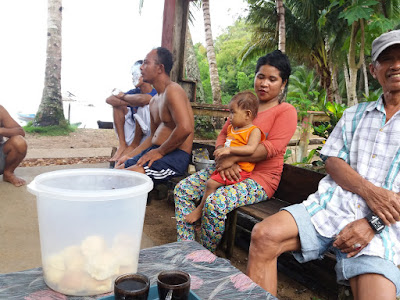
💜They chat, eat snacks, drink coffee, care for children, prepare vegetables for dinner or fishing equipment for the next day.
Namu is reputed to be free of mosquitoes - so some must have hitched a lift as they still found me.
Behind the village, mixed native forest gives an undulating backdrop of variegated green, to the top of a very steep hill and continuing unbroken from side to side. Apparently monkeys are often seen in the tree tops.
💜According to the villagers, only a short road will be cut through this gap in the hill to connect Namu to the major road now under construction.
Indonesia has a long tradition of 'pulang' ['returning home', but originally 'to go upriver' suggesting an isolated locality]. Hence their link to place of origin is very strong, reinforced by oral history and tradition, which can even predate religious ties.
Last year I started collecting stories or any oral miscellany, preferably in bahasa lokal. These are transcribed and translated into bahasa Indonesia for me by friends from the region. When translated into English I plan to return them to my source in all three languages, thus helping to preserve a little of the history and culture of the places I come to know.
Which is not a bad excuse for exploring, making new friends and having new experiences, while having a lot of fun.
💜My source of the tradition of Kalosara, recorded in bahasa lokal, while sporting my hat.
In Kendari I heard of a tradition called 'Kalosara', an artifact used in wedding ceremonies only by suku Bugis [Bugis tribe]. Both pengantin [wedding participants] must be of suku Bugis origin. As Namu is populated by suku Bugis, the village was able to provide both a demonstration of how this tradition is presented at a wedding, and a recounting of the custom.
💜 Kalosara, as presented at a wedding - a circle of bamboo, daun sirih [betel leaf] and buah pinang [areca nut or betel nut].
A pleasant walk to Namu Two took us to another bay from which we could glimpse Namu Three and Four, both still only accessible by boat.
Waves are blamed for much of the damage to coral that affects the snorkelling and must eventually affect the fishing. With fish at almost every meal, it is not surprising if the village wants protection of their main food source to be a priority.
💜 A sea wall is being constructed across the bay of Namu Two, with rocks transported by perahu. Evidently, while cut off from much of civilisation, Namu is not exempt from the effects of climate change.
Waves are blamed for much of the damage to coral that affects the snorkelling and must eventually affect the fishing. With fish at almost every meal, it is not surprising if the village wants protection of their main food source to be a priority.
💜 Fish for dinner, three ways - grilled, fried and in tumeric sauce as the dish 'Pallumara'. All are delicious.
💜 High tide makes Namu One as busy as a port, with the to and fro of fishing boats.

💜 Bringing in the net. The building over the water is used for cleaning fish.
💜 Dealing with the catch of bait fish; plenty of willing helpers - and chat - to clear the net.
💜 The younger fishermen go only to the mouth of the bay in small one-man perahu called 'roda', named after the tree from which the single log is hewn.
We visited the waterfall, called Pitu Noengga, narrow but with an impressive quantity of water. Led by a guide more nimble than his age would seem to allow, we walked up a steep hill through a 'kebun' [garden] of mixed crops where ubi [sweet potato], turmeric, pohon pala [nutmeg tree], pohon cengkeh [clove tree] durian, nangka [jackfruit], all grow according to their season. The ubiquitous coconut and banana are also part of the local produce.
The children swarmed up the rocky torrent, led by Dheny and his camera. However they poured back down again very quickly as the rain returned. We had a long wet walk back, accompanied by thunder seemingly just at our shoulder.
💜 Turmeric growing in the kebun.
The children swarmed up the rocky torrent, led by Dheny and his camera. However they poured back down again very quickly as the rain returned. We had a long wet walk back, accompanied by thunder seemingly just at our shoulder.
💜 Similarly with other Sulawesi waterfalls, wet rock gives good grip for bare feet or sandals, while dry rock is less safe.
A major feature of any village life is the children. Of course they were shy, but not as fearful as many children I have met in Indonesia, who find my white face so strange.
💜 These children were entranced by the opportunity to look through the viewfinder of Dheny's camera. Providing fuel for the generator at the Rumah Kepala Desa, the only one in Namu, meant another rare treat, an evening of TV.
Next day Pak Paul took us by perahu to various spots in the bay so I could snorkel. Naturally my best shots were the ones I didn't get, especially of what looked like a medium-sized fish with frilly blue fins - it disappeared down a hole in the rocky seabed under the headland before my camera was in range. Sadly, there was much damage to the coral - due to fish bombing, waves or both.
💜Tiny blue fish exist in a world whose extent is measured only in millimetres. Their movement creates a traffic light effect of blue, yellow, blue, yellow, as they ⇄ en masse, never to leave their small coral home.
💜 A glass-like sea.
Community-inspired programs have already begun to help restore and regenerate the damaged aquatic environment.
💜 The amazing placidity and clarity of the sea more than made up for the snorkelling.
To any tourists or researchers wishing to visit Desa Namu: please contact
Yasril La Ery
email : yasril02@yahoo.com
phone : +62 8524 151 8932
+62 8524 151 8932
What's App : +62 8129 859 7634
Facebook : Yasril Rhilone
Website : under development
Whether seeking up-to-date local information to assist in making your own arrangements in Sulawesi Tenggara, or a personal guide to arrange bookings and transport you to places of interest, Yasril's new travel business "Face of Sultra" can meet your needs.
Website : under development
Whether seeking up-to-date local information to assist in making your own arrangements in Sulawesi Tenggara, or a personal guide to arrange bookings and transport you to places of interest, Yasril's new travel business "Face of Sultra" can meet your needs.

